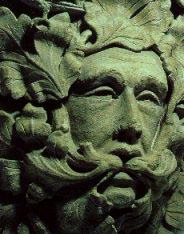Introduction:

Hauntingly wise Green Man "speaking" in hawthorn leaves.
Parish Church in Sutton Benger, UK (c.1300) |

Green Man, detail of a medieval misericord in Ludlow parish church.
|
 Myths, Legends, and Sacred Stories
Myths, Legends, and Sacred Stories
On March 14, 2010 The Eastern Native Tree Society and Western
Native Tree Society switched from discussion lists on Google
Groups to a new discussion list in a Bulletin Board format at:
http://www.ents-bbs.org/index.php Posts made since the
inception of the BBS on march 14, 2010 will be sorted and
archived on the BBS. Click on the link above to go to the
equivalent section on the new BBS. This website will continue to
serve as a front end for the ENTS and WNTS groups. It will
continue to serve as a repository of older posts, and will serve
as the host site for special projects and features that are not
well suited for a BBS format. Please visit the BBs for the
latest information and trip reports.
Myths, Legends, and Sacred Stories
by Edward Forrest Frank
In this section I am using the word myth in the scholarly
sense. It refers to a story of a supernatural, sacred, or religious
nature that relates the world of man, to the natural world, and
to the supernatural. All myths are, at some stage,
believed to be true by the peoples of the societies that used or
originated the myth The Oxford English Dictionary defines
the word: "A traditional story, typically
involving supernatural beings or forces or creatures , which
embodies and provides an explanation, aetiology, or
justification for something such as the early history of a
society, a religious belief or ritual, or a natural phenomenon."
Myth by this definition is clearly distinguished from the use of the
word in everyday speech, in which it basically refers to any
unreal or imaginary story. If a story is referred to a
myth in this section, it is not meaning or implying that the
story is false or imaginary, but simply a story of a religious
or sacred nature.
Virtually every religion in the world has stories involving
trees in their sacred literature. In the Judeo-Christian
religious tradition are accounts of the Garden of Eden, and the
Tree of Knowledge of Good and Evil, in the very first book of
the Bible. Other religions, both past and present, also
have passages in which trees play an important role in defining
the relationship among man, nature, and higher beings or
gods..
The other major category of stories to be represented here
are allegories, fables, and parables. These commonly use
the same thematic elements as other sacred stories, but are
designed to teach the reader or listener about some value or
concept. These are generally acknowledged to be fictional
in nature, but still play an important role in the context of a
particular religion. One thing to consider is that many of
these stories were told by generations of people around
campfires before they were ever put to paper. Many
therefore are meant to be told aloud, and listened to, rather
than to be quietly read.
|